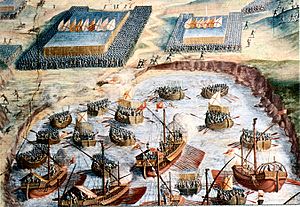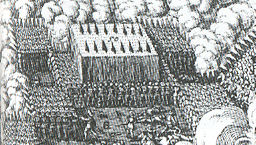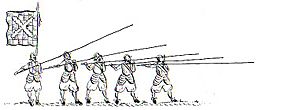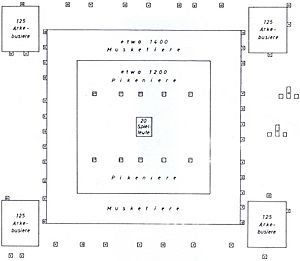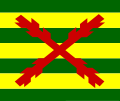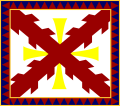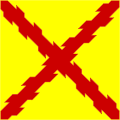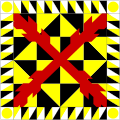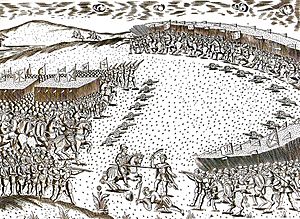Tercio facts for kids
Quick facts for kids Spanish Tercios |
|
|---|---|
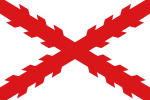 |
|
| Founded | 1 January 1534 (de jure establishment) |
| Country | Spain
See details
Habsburg Spain (1534-1704)
|
| Type | Infantry |
| Role | Close combat Hand-to-hand combat Hedgehog defence Pike square Raiding Volley fire |
| Part of | Spanish Armed Forces |
| Patron | Ferdinand II Charles V, Holy Roman Emperor Philip II of Spain Philip III of Spain Philip IV of Spain Charles II of Spain Charles VI, Holy Roman Emperor |
| Motto(s) | Spain my nature, Italy my fortune, Flanders my grave |
| Equipment | Arquebuses, muskets, and pikes |
| Commanders | |
| Gran Capitán | Gonzalo Fernández de Córdoba |
| Comandante | John of Austria Emmanuel Philibert, Duke of Savoy |
| Field Master of Navarre | Don Gaspar Pineiro de Elio Esparza and Artieda Velaz de Medrano, Lord of Elio, etc. |
| Governor of the Tercio of Álava | Pedro Velaz de Medrano y Manso de Zúñiga, II Count of Tabuérniga, Governor of five galleons of Naples, Admiral of the squadron, etc. |
| Insignia | |
| War flag | |
A Tercio (pronounced: TEHR-thyo) was a special military unit in the Spanish Army. These units were famous during the time of the Catholic Monarchs and the Spanish Habsburgs, from the 1500s to the 1700s.
The Tercios were known as the best professional foot soldiers in Europe for over 150 years. They were super effective because of their unique battle formations. These units were the elite (best of the best) parts of the Spanish Monarchy's army. They were key to the powerful land forces of the Spanish Empire, and sometimes even fought with the navy.
The Spanish Tercios were a big step in creating modern European armies. They were made up of professional volunteers, not soldiers forced to join or hired mercenaries. Other European countries usually used these less reliable types of soldiers back then.
The way the Tercios were organized and fought came from new ideas by Gonzalo Fernández de Córdoba. This happened during the conquest of Granada and the Italian Wars in the late 1400s and early 1500s. He was the first to successfully combine pikes and firearms (like arquebuses). The Tercios brought back the importance of infantry (foot soldiers) on the battlefield, much like the ancient Macedonian phalanxes and Roman legions.
These units showed their strength in famous battles like the Battle of Bicocca (1522) and the Battle of Pavia (1525). After they were officially formed in 1534, the Tercios became strong because of their great training. They also had many "old soldiers" (called veteranos) and were led by brave lower nobility. The Tercios were eventually replaced by new army groups called regiments in the early 1700s.
Since 1920, the name Tercio has been used for units in the Spanish Legion. These are professional units created to fight colonial wars in North Africa. They are similar to the French Foreign Legion. These modern units are actually regiments, but they use Tercio as an honorary title.
Contents
History of the Tercios

During the Granada War (1482–1491), Spanish soldiers were divided into three types. There were pikemen, who used long spears like the Swiss. There were swordsmen with shields. And there were crossbowmen, who later used early firearms called arquebuses. As shields disappeared and firearms became more common, Spain won many battles in Italy. This started under the leadership of Gonzalo Fernández de Córdoba (1453–1515), known as El Gran Capitán (The Great Captain).
His changes to the Spanish army helped create the Tercios. The Spanish armies, using both pikes and firearms, were very effective. They could also break into smaller, mobile groups without losing their strength. This was a big advantage over other armies.
At first, tercio meant an administrative group, not a fighting unit. It managed soldiers in different parts of Italy. This continued when they fought in Flanders. The king directly appointed the commanders of a tercio and its companies. Companies could be easily added or moved between tercios. By the mid-1600s, nobles started raising tercios themselves. They paid for them and appointed the captains, owning the units like in other European armies.
From 1492 to 1495, three main rules shaped the Spanish military. In 1503, the "Great Ordinance" introduced long pikes and specialized infantry companies. In 1534, the first official tercio was created in Lombardy. A year later, it helped conquer the Duchy of Milan. The tercios of Naples and Sicily were formed in 1536.
At the Battle of Mühlberg in 1547, the Spanish tercios helped Charles V's troops defeat Protestant princes in Germany. In 1557, the Spanish army totally beat the French at the Battle of San Quentin. They won again in 1558 at Gravelines. These victories led to a peace treaty that greatly favored Spain. In all these battles, the Tercios showed how effective they were.
The exact origin of the word tercio is not fully known. Some historians think it came from a Roman Legion in Spain called tercía. Others believe it referred to the three main parts of the Spanish forces in Italy. Some link it to the three types of fighters: pikemen, arquebusiers, and musketeers. An old military rule from 1497 said infantry should be divided into three parts:
- One part with spears (pikes).
- Another part with shields (swordsmen).
- The last part with crossbowmen (later replaced by arquebusiers).
Still others think the name came from the three thousand men in the first units. A commander named Sancho de Londoño supported this idea in the 1500s. He said that even if tercios later had fewer men, the name stuck.
How Tercios Were Organized
Other countries copied the battle formations of the Tercios. But their armies never matched the amazing reputation of the Spanish army. This army had a core of very experienced professional soldiers. It also included soldiers from other nations like Germany, Italy, and the Spanish Netherlands. In 1621, for example, only seven of 47 Spanish army units were made up of Spanish soldiers. This mix of nationalities was common in European wars before the Napoleonic Wars. However, the main Spanish troops were known for their teamwork, strong discipline, and overall professionalism.
Unit Structure
At first, each tercio in Italy and the Spanish Netherlands had:
- 10 companies, each with 300 soldiers.
- 8 companies were pikemen.
- 2 companies were arquebusiers.
Later, companies were reduced to 250 men. The number of arquebusiers (and later musketmen) compared to pikemen steadily increased.
During early fights in the Netherlands, tercios were reorganized. They were split into three coronelias (colonelcies), led by coronels (colonels). Each had a headquarters and four companies. But the tercio as a whole still had 10 companies of 250 men each. Two were arquebusiers and eight were pikemen. Colonels were also chosen by the king.
Leaders and Roles
A tercio was led by a Maestre de Campo (commanding officer). The king appointed this leader, who had a guard of eight halberdiers (soldiers with axe-like weapons). Helping the maestre was the sergeant major and a furir major. The furir major was in charge of supplies and weapons.
Companies were led by a captain, also chosen by the king. An ensign carried the company's flag.
Other important roles in a company included:
- Sergeants: Second-in-command, passing orders.
- Furrieles: Provided weapons, ammo, and extra help.
- Corporals: Led groups of 25 soldiers, watching for problems.
Each company had drummers and fifers. They played calls during battle. The main drummer and fifer were part of the tercio's headquarters.
The tercio staff also included medical helpers (a medic, a barber, and surgeons). There were also chaplains and preachers. A legal unit and military police (constables) helped keep order. All these people reported directly to the Maestre de Campo.
Battle Formations
Inside a tercio's square formation, pikemen stood in a hollow pike square (called cuadro). This square held swordsmen inside, who used short swords, bucklers (small shields), and javelins. As firearms became more important, the swordsmen were used less.
The arquebusiers (who later became musketeers) were usually split into mobile groups called "sleeves" (mangas). They were often placed at each corner of the cuadro. This mix of weapons meant the formation had:
- The strength of pikemen to stop cavalry.
- The long-range firepower of arquebusiers.
- The close-combat power of swordsmen.
Over time, the number of swordsmen was reduced and then removed. The number of gunmen compared to pikemen increased. The arquebusiers' long-range fire could easily be moved to the sides. This made the formation good for both attacking and defending.

Groups of squares were often arranged in a "dragon-toothed" shape. This meant units were staggered, with one unit's front edge lining up with the unit behind it. This allowed for enfilade (firing along the length of enemy lines). It also protected the army units somewhat. Odd units stood forward, while even units were stepped back. This created gaps for enemies to enter, exposing their sides to crossfire from three different squares. Tercio companies also carried out special missions on their own.
Tercios and the Spanish Empire
Tercios were sent all over Europe by the Habsburg rulers. They were made of volunteers and had a core of professional soldiers. They were highly trained. Sometimes, later tercios didn't follow the all-volunteer rule. When King Philip II needed more troops, he even raised a tercio of Catalan criminals to fight in Flanders. He continued this trend for the rest of his rule.
A large part of the Spanish army was made of tercio units. For example, the Tercio of Savoy and the Tercio of Sicily were sent to the Netherlands. Their job was to stop the growing rebellion against the Habsburgs. But sometimes, the unpaid tercios became a problem. The Spanish government often ran out of money due to constant wars. This led to unpaid units rebelling. For example, in April 1576, after a big victory, unpaid tercios rebelled. They took over the friendly city of Antwerp and looted it for three days. This event was called the Spanish Fury at Antwerp. The Spanish commander had no choice but to let them.
Specialized Tercios
On February 24, 1537, the Tercio de Galeras (Tercio of Galleys) was created. Today, the Real Infantería de Marina (Spanish Marine Infantry) sees itself as the heir to the Galleys Tercios. This makes it the oldest continuously operating marine unit in the world. There were other naval tercios too, like Tercio Viejo de Armada (Old Navy Tercio). These special units were needed for the long war against the Ottoman Empire across the Mediterranean.
Naming Tercios
Most tercios were named after the place where they were formed or first sent. For example, Tercio de Sicilia, de Lombardía, or de Nápoles. Other tercios were named after their commanding officer, like Tercio de Moncada. Some were named by their main job, such as Galeras (Galleys) or Viejo de Armada (Old Navy).
Tercio Flags
-
The Cross of Burgundy was the symbol of the Tercios and the Spanish Empire.
Portuguese Terços
Portugal also started using the Spanish tercio model in the 1500s. They called them terço. In 1578, King Sebastian reorganized the Portuguese Army. He created four terços: Lisbon, Estremadura, Alentejo, and Algarve. Each had about 2,000 men, divided into eight companies.
The army for the 1578 expedition to Morocco included these four terços. It also had the Terço of the Adventurers (made of young nobles). Plus, there were three mercenary terços (German, Italian, and Castilian). An elite unit of sharpshooters from Tangier also joined. This was the Portuguese force that fought in the Battle of Alcácer Quibir.
When Portugal was united with the Spanish Crown (1580-1640), it kept the terços organization. However, the army had become weaker. Several Spanish tercios were sent to Portugal. The main one, the Spanish infantry Tercio of Lisbon, held the capital's main forts. The Terço of the Navy of the Crown of Portugal was also created then. It is the ancestor of the modern Portuguese Marines.
After Portugal regained its independence in 1640, King John IV of Portugal reorganized the army. Terços remained the main units of Portuguese infantry. Two types were formed: paid terços (first-line permanent units) and auxiliary terços (second-line militia units). Portugal won the Restoration War using these terços.
By the late 1600s, terços were already organized like modern regiments. However, the first-line terços only became regiments in 1707. This happened during the War of the Spanish Succession, after the Spanish tercios changed in 1704. The second-line terços became militia regiments in 1796. Some old terços are direct ancestors of today's Portuguese Army regiments.
End of an Era: Evolution and Replacement
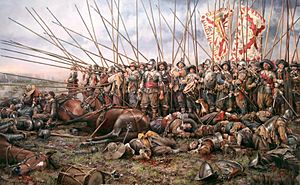
The first big challenge to the Spanish tercios' power came at the Battle of Nieuwpoort (1600). The winner, the Dutch leader Maurice, Prince of Orange, thought he could make the tercio better. He combined their methods with the organization of the Roman legion. His new formations were shallower, allowing more guns to fire at the enemy at once. At Nieuwpoort, the tercio squares were badly damaged by the Dutch firepower. Yet, the Spanish army almost won despite internal problems.
The Eighty Years' War (1568–1648) in the Low Countries was mostly about sieges of cities and forts. Field battles were less important. Maurice's changes didn't cause a total revolution in warfare. But he did create an army that could fight the tercios equally. This showed the way for future military developments.
During the Thirty Years War (1618–1648), tercio-style formations of the Holy Roman Empire lost big battles. This was against more linear formations created by the Swedish king Gustavus Adolphus. However, the proven tactics and professionalism of the Spanish tercios helped defeat the Swedish army at the Battle of Nördlingen.
Throughout their history, the tercios changed to meet new challenges. The classic pike and shot square formations, with good cavalry support, kept winning major battles in the 1600s. These included Wimpfen (1622), Fleurus (1622), Breda (1624), Nördlingen (1634), Thionville (1639), and Honnecourt (1641).
It wasn't until Rocroi (1643) that the Spanish tercio's reputation for being unbeatable in open battle was broken. Even then, the defeat at Rocroi was caused by the cavalry failing, not the tercio infantry. After Rocroi, tercios still won battles like Tuttlingen (1643) and Valenciennes (1656). Their structure and fighting style kept changing.
By the late 1600s, firearms and artillery were getting better. This made linear fighting styles more effective. The tercios adopted so much of the linear style that their formations looked very different from a century before. In 1704, the regular Spanish tercios became regiments. The pikeman as a type of soldier was removed. Reserve and militia tercios also changed later.
Famous Battles
Victories
Before Official Name
- Cerignola (1503)
- Garigliano (1503)
- La Motta (1513)
- Noáin (1521)
- Bicocca (1522)
- Sesia (1524)
- Pavia (1525)
- Rome (1527)
- Landriano (1529)
- Vienna (1529)
After Official Name
- Tunis (1535)
- Serravalle (1544)
- Muhlberg (1547)
- St. Quentin (1557)
- Gravelines (1558)
- Great Siege of Malta (1565)
- Lannoy (1566)
- Dahlen (1566)
- Oosterweel (1567)
- Jemmingen (1568)
- Jodoigne (1568)
- Lepanto (1571)
- Mons (1572)
- Goes (1572)
- Haarlem (1573)
- Mook (1574)
- Valkenburg (1574)
- Schoonhoven (1575)
- Oudewater (1575)
- Zierikzee (1576)
- Gembloux (1578)
- Borgerhout (1579)
- Maastricht (1579)
- Noordhorn (1581)
- Terceira (1582)
- Steenbergen (1583)
- Empel (1585)
- Antwerp (1585)
- Neuss (1586)
- Rheinberg (1590)
- Relief of Paris (1590)
- Craon (1592)
- Doullens (1595)
- Calais (1596)
- White Mountain (1620)
- Fleurus (1622)
- Wimpfen (1622)
- Breda (1625)
- Cádiz (1625)
- Genoa (1625)
- Salvador de Bahia (1625)
- Nordlingen (1634)
- Leuven (1635)
- Venlo (1637)
- Kallo (1638)
- Thionville (1639)
- Honnecourt (1642)
- Tuttlingen (1643)
- Valenciennes (1656)
Defeats
- Ravenna (1512)
- Castelnuovo (1539)
- Algiers (1541)
- Ceresole (1544)
- Leiden (1574)
- Rijmenam (1578)
- Alcácer Quibir (1578)
- Arques (1589)
- Ivry (1590)
- Caudebec (1592)
- Morlaix (1594)
- Fort Crozon (1594)
- Fontaine-française (1595)
- Amiens (1597)
- Turnhout (1597)
- Zaltbommel (1599)
- Nieuwpoort (1600)
- Kinsale (1601)
- Sluis (1604)
- Les Avins (1635)
- Tornavento (1636)
- Schenkenschans (1636)
- Turin (1640)
- Montjuïc (1641)
- Lleida (1642)
- Rocroi (1643)
- Lens (1648)
- Arras (1654)
- The Dunes (1658)
- The Lines of Elvas (1659)
- Ameixial (1663)
- Castelo Rodrigo (1664)
- Montes Claros (1665)
See also
 In Spanish: Tercio para niños
In Spanish: Tercio para niños
- Pike and shot
- Musketeer
- Captain Alatriste
- Military history
- Spanish Navy Marines units are called tercios
- The units of the modern Spanish Legion are also called tercios.



